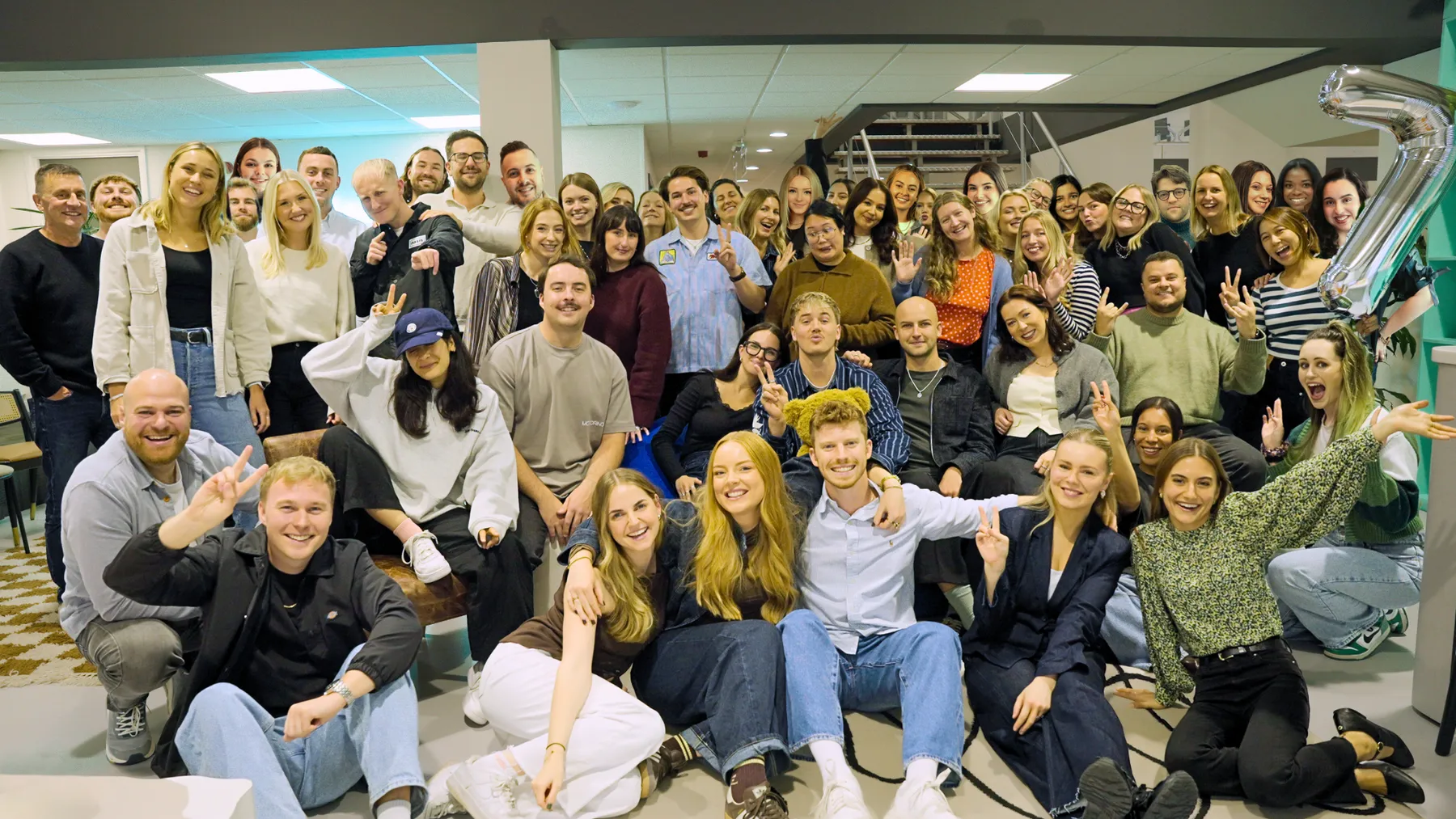33 Essential ChatGPT Statistics You Need To Know In 2025

Contents
- What to Know Before Learning These ChatGPT Statistics
- ChatGPT Usage Statistics
- ChatGPT Demographics Statistics
- ChatGPT UK Statistics
- ChatGPT US Statistics
- ChatGPT Worldwide/Global Statistics
- ChatGPT Marketing & Advertising Statistics
- ChatGPT App Statistics
- ChatGPT in 2025
- Want More Great Marketing Statistics?
Over the last two years, we’ve been hearing more and more about ChatGPT and the use of artificial intelligence (AI) for writing.
It seems that once Ammaar Reshi used the popular AI platform to write and illustrate a children’s book in 2023, it has raised questions about how AI can help in the writing industry, and how it might hurt.
At The Social Shepherd, we understand these concerns. However, we also know that artificial intelligence can be extremely helpful, when used in ethical ways. And while nothing can truly replace the benefits that come with human writers, it’s important to understand the impact ChatGPT is making in the marketing and advertising space.
In this article, we’ll share some pretty insightful statistics about ChatGPT. And trust us, these are statistics you will want to be aware of.
What to Know Before Learning These ChatGPT Statistics
Though we touched on it above, let’s provide a bit more background about the rise of ChatGPT and why it has become so popular in the marketing and advertising space.
ChatGPT Was Created by OpenAI in 2022
ChatGPT was created by OpenAI, an artificial intelligence research company founded in 2015 by a group of tech leaders and researchers, including Elon Musk and Sam Altman. The goal was to develop AI technology that could benefit humanity, and in November 2022, they launched ChatGPT to the public.
Since then, the tool has gained widespread attention, especially in marketing and advertising. Professionals in these industries now use ChatGPT for everything from writing blog posts and ad copy to personalizing customer messages and improving email campaigns. It’s also being used to generate keyword-rich content for SEO and assist with market research by analyzing trends and patterns in consumer behavior.
As we get into the latest ChatGPT statistics, keep this context in mind: this isn’t just a passing trend. It’s a tool that’s already reshaping how businesses connect with audiences, and the numbers prove it.
ChatGPT Usage Statistics
ChatGPT Currently Has 4 Different Language Models
Today, “ChatGPT” refers to more than just one AI tool. It’s the more commonly used name to describe several of OpenAI’s advanced language models, including GPT-3.5, GPT-4, GPT-4o, and GPT-4.5. These models power everything from simple chat applications to advanced business tools used across industries.
ChatGPT Reached 1 Million Users Within 5 Days of Launching
The growth of ChatGPT has been nothing short of explosive. Within just five days of its launch in November 2022, the platform reached 1 million users. That rapid adoption signaled what was to come.
ChatGPT Has 400 Million Weekly Users
Now, ChatGPT.com sees approximately 5.43 billion visits each month (or more). Clearly, this shows how widely adopted and frequently accessed the tool has become. According to OpenAI’s Chief Operating Officer Brad Lightcap, ChatGPT currently has 400 million weekly users, and the company is aiming for one billion users by the end of 2025.
62% of ChatGPT's Social Media Traffic Comes from YouTube
Interestingly, 62% of ChatGPT’s social media traffic comes from YouTube, showing how integrated the platform has become with educational and video content channels.
ChatGPT Gets 5.43 Billion Monthly Visits
With more than 5.43 billion monthly visits, ChatGPT isn’t just a tool. It’s a daily habit for millions. From marketers to students to developers, people rely on it to brainstorm, research, write, and problem-solve. The traffic volume shows just how embedded ChatGPT has become in everyday processes and procedures.
ChatGPT Demographics Statistics
Now let’s talk demographics. One reason ChatGPT has become so popular is its simple, user-friendly interface. Whether you’re a student, professional, or just curious about AI, the experience is intuitive enough for users of all ages and backgrounds.
Over 54% of ChatGPT Users Are Male
In terms of gender, usage is relatively balanced.
54.74% of ChatGPT users are male
45.26% of ChatGPT users are female
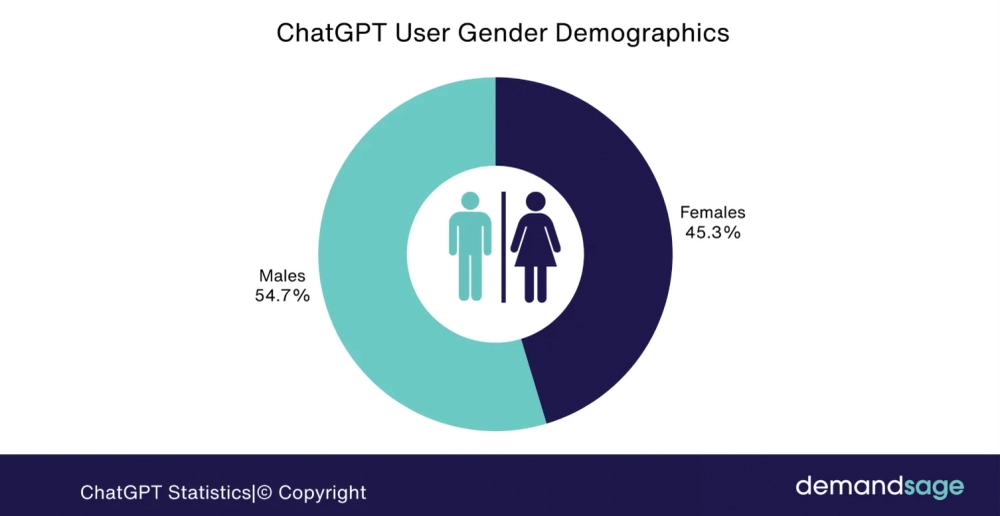
This near-equal split highlights the platform’s wide appeal and accessibility.
Over Half of ChatGPT Users Are Between 18 and 34
When it comes to age, the majority of ChatGPT users fall between 18 and 34 years old, making up 54.85% of the total user base. These are likely college students, early-career professionals, and digital natives using ChatGPT for everything from homework help to content creation.
31.91% of ChtGPT Users Are Aged 35 to 54
Interestingly, mid-career professionals aged 35 to 54 also make up a large portion of users, 31.91%, suggesting that it’s not just a tool for younger generations. However, usage does decline with age: only 13.25% of users are 55 or older, and just 5.15% are over 65, showing that adoption remains lower among older adults.
ChatGPT UK Statistics
UK Users Are Spending An 4 Hours and 20 Minutes Online Every Day
People in the UK are among the heaviest internet users in the world. UK adults are spending an average of 4 hours and 20 minutes online each day. That’s nearly a fifth of their time awake. That includes everything from streaming and shopping to gaming and, increasingly, using AI tools like ChatGPT.
Nine Out of Ten UK Graduates Use AI Tools in Their Assessments
Among younger users, ChatGPT has already become part of the academic routine. In one recent survey, nine out of ten UK undergraduates admitted to using generative AI tools in their assessments, suggesting widespread adoption among students.
While AI is being used regularly by many in the UK, workplace adoption is slower compared to global averages. According to the EY AI Sentiment Index, 70% of UK respondents said they had used AI in their daily lives in the past six months, which is lower than the global average of 82%.
22% of People in the UK Use ChatGPT
Top ways UK users engage with AI include accessing customer support (32%), route planning (20%), and product recommendations (14%). When it comes to ChatGPT specifically, 22% of UK residents report using the tool.
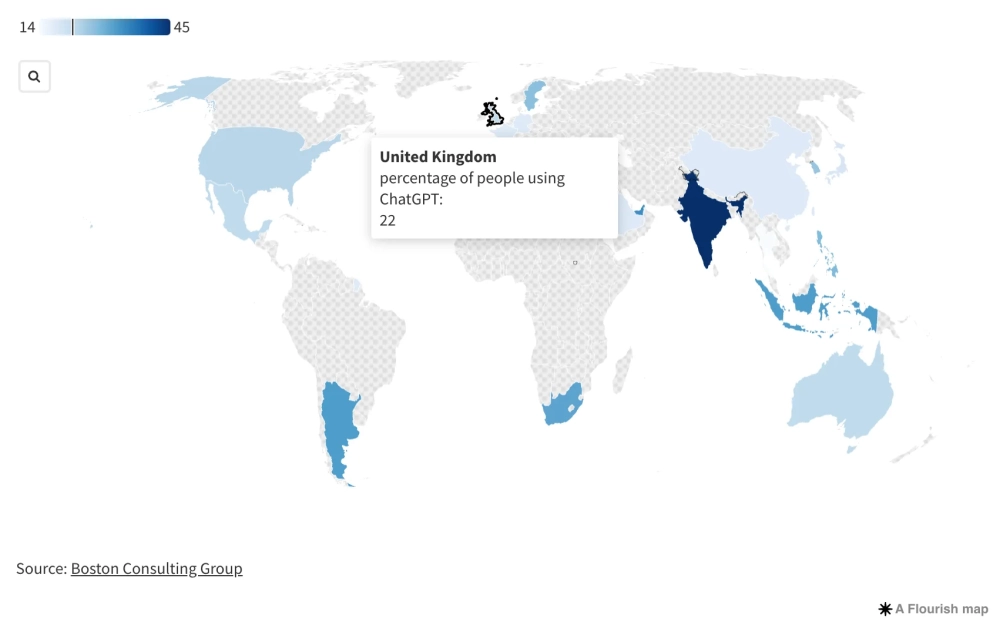
Roughly one in five UK residents has used ChatGPT, which shows there is definitely some growing interest, especially among students and professionals. While usage rates in the UK trail slightly behind global trends for writing and idea generation, they’re higher when it comes to career planning and reviewing work, showing a unique application of AI in everyday life.
ChatGPT US Statistics
An Estimated 43% of U.S. Adults Aged 18 to 29 Have Tried ChatGPT
So, what about ChatGPT usage in the U.S.? It’s big there, too. In fact, 67.7 million people in the United States are using ChatGPT. Usage is especially strong among young adults. An estimated 43% of U.S. adults aged 18 to 29 have tried ChatGPT, making them the most active age group.
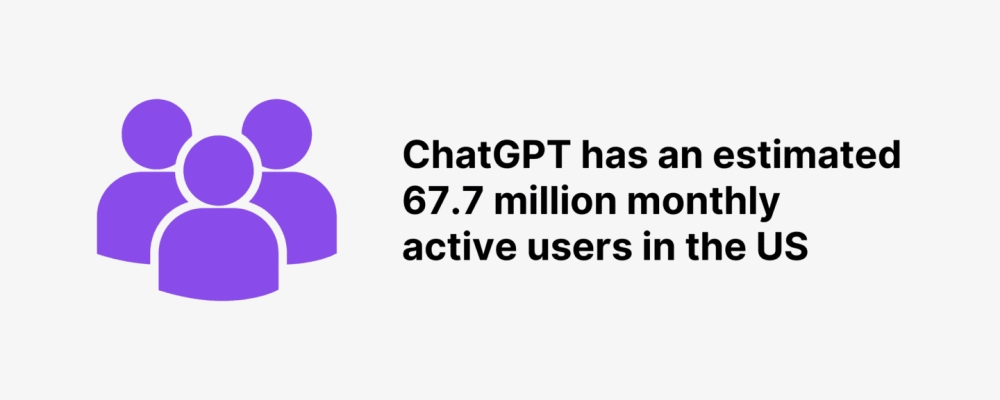
In contrast, adoption is much lower among older Americans, with only 6% of adults aged 65 and older reporting that they’ve ever used the tool. This reflects a generational divide in AI familiarity and digital engagement.
ChatGPT Worldwide/Global Statistics
With such high usage in the UK and the U.S., it’s natural to ask: how does ChatGPT stack up globally?
The United States Accounts For 19.01% of All ChatGPT Users
As of 2025, the United States accounts for 19.01% of all ChatGPT users, followed by India at 7.86%, Brazil at 5.05%, Canada at 3.57%, and the United Kingdom at 3.48%. The remaining 61.03% of users are spread across other countries, which shows ChatGPT’s impressive and wide international reach.
Usage patterns also vary by frequency and region, according to Reuters Institute data:
| Country | Daily Use | Weekly Use | Monthly Use |
| United States | 7% | 11% | 4% |
| Denmark | 3% | 8% | 9% |
| United Kingdom | 2% | 7% | 6% |
| Argentina | 5% | 7% | 5% |
| France | 2% | 7% | 5% |
| Japan | 1% | 5% | 4% |
Japan Reports the Lowest Daily Use of ChatGPT
Only 1% of people in Japan use ChatGPT daily. This is the lowest of any country surveyed. This points to cultural and workplace differences in AI adoption. While Japan is known for its tech innovation, we anticipate that many users remain cautious about relying on generative AI tools, favoring traditional workflows or slower integration into daily life.
ChatGPT Marketing & Advertising Statistics
In the marketing and advertising space, ChatGPT has quickly become a go-to tool for improving efficiency, content quality, and creative output. Whether used alone or alongside other AI platforms, its impact is clear across industries and company sizes.
Here are some standout statistics:
49% of companies are currently using ChatGPT, and 93% of those plan to expand their usage.
Over 80% of Fortune 500 companies adopted ChatGPT within the first nine months of its release.
64% of journalists, 63% of software developers, and 65% of marketers use the platform regularly.
According to a SurveyMonkey study, AI tools, including ChatGPT, are being used for:
51%: Optimizing content for email marketing and SEO
50%: Creating content to support existing strategies
45%: Brainstorming new content ideas and campaigns
49% of Companies Use ChatGPT, But How Is the Business Behind It Performing?
With nearly half of all companies now using ChatGPT, the demand for the tool has far exceeded OpenAI’s early expectations. To meet that demand and generate sustainable revenue, OpenAI introduced ChatGPT Plus, a premium subscription priced at $20 per month. Subscribers get priority access during peak times, faster response speeds, and early access to new features and benefits that appeal to both individual users and businesses.
ChatGPT Generated $2.7 Billion in Revenue
That strategy is clearly working. In 2024, ChatGPT generated $2.7 billion in revenue, making up roughly 75% of OpenAI’s total earnings. As enterprise adoption continues to grow, so does ChatGPT’s role, not just as a tool, but also as a strategic asset. And it is definitely a major business driver in the AI industry.
ChatGPT App Statistics
ChatGPT Ranks In The Top Ten Most Downloaded Apps Worldwide
ChatGPT quickly rose to the top of both app stores, frequently ranking among the top ten most downloaded apps worldwide. Its intuitive interface and powerful capabilities made it a go-to for users seeking instant support, content creation help, or general AI-powered assistance on the go.
Here’s a breakdown of global ChatGPT app downloads:
H1 2023: 13 million downloads
H2 2023: 90 million downloads
H1 2024: 105 million downloads
H2 2024: 174 million downloads
H1 2025: 350 million downloads
650 Million People Use AI Apps Worldwide
Beyond ChatGPT alone, over 650 million people now use AI apps worldwide, with ChatGPT jumping out as the most widely used among them. This rapid growth reflects not just interest, but real demand for practical, everyday AI tools.
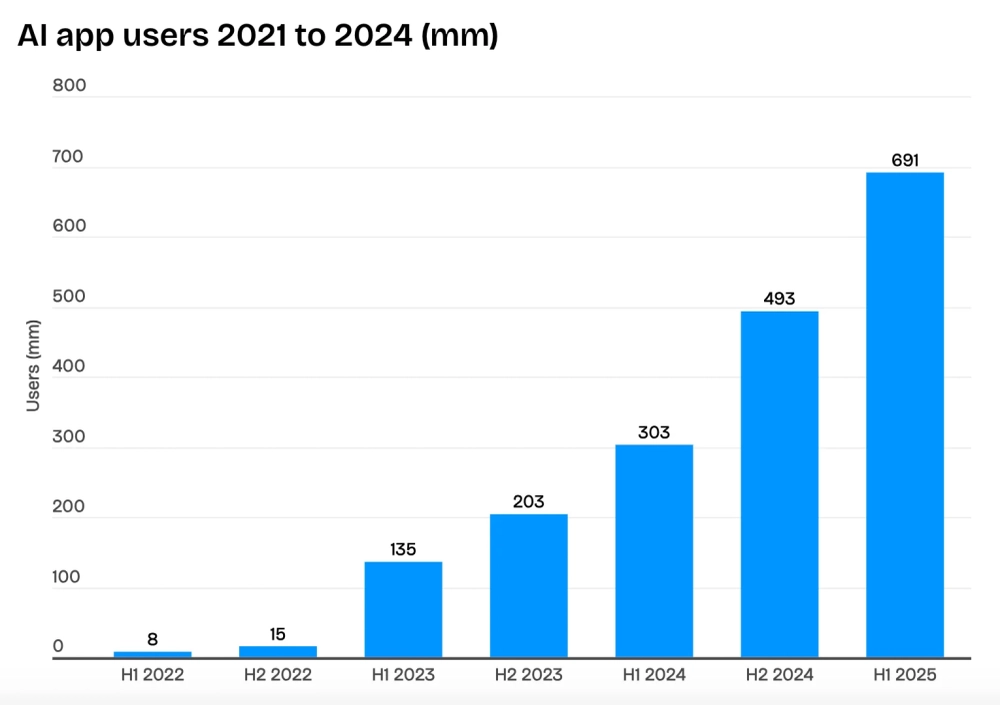
ChatGPT in 2025
ChatGPT isn’t just a tech trend, it’s a powerful tool that’s already reshaping how brands operate, communicate, and grow. The statistics we’ve covered here show just how far-reaching its impact has become, from individual creators to global enterprises.
With a massive user base, strong adoption across industries, and billions of app downloads, ChatGPT has earned its place in your 2025 marketing strategy. Whether you’re using it to generate content, improve customer interactions, or streamline creative workflows, ChatGPT offers efficiency and innovation when used the right way.
To get the most out of ChatGPT while maintaining trust with your audience, follow these best ethical practices:
Be transparent: Always disclose when content is AI-assisted.
Review and edit: Use ChatGPT as a starting point, not a final draft.
Avoid bias: Check for fairness and accuracy in outputs.
Protect privacy: Never input sensitive or personal information.
Stay human: Let AI support your voice, not replace it.
At The Social Shepherd, we’re here to help you balance innovation with integrity. Whether you need support with social, paid, creative, or influencer marketing, our team is ready to help your business grow strategically and responsibly.
Want More Great Marketing Statistics?

You might also like
Don’t be sheepish
let’s talk
